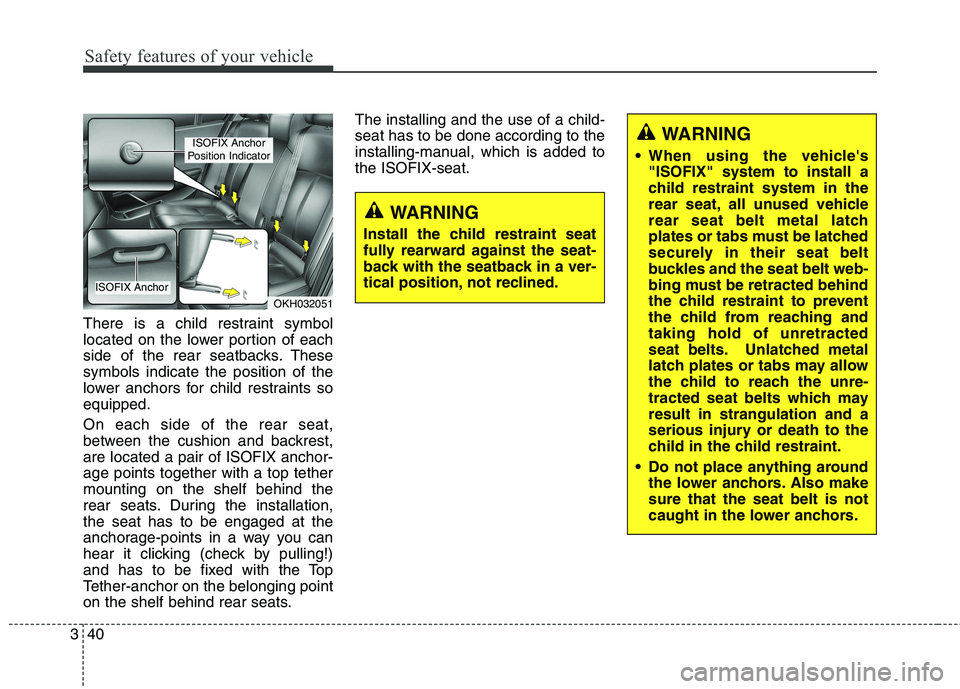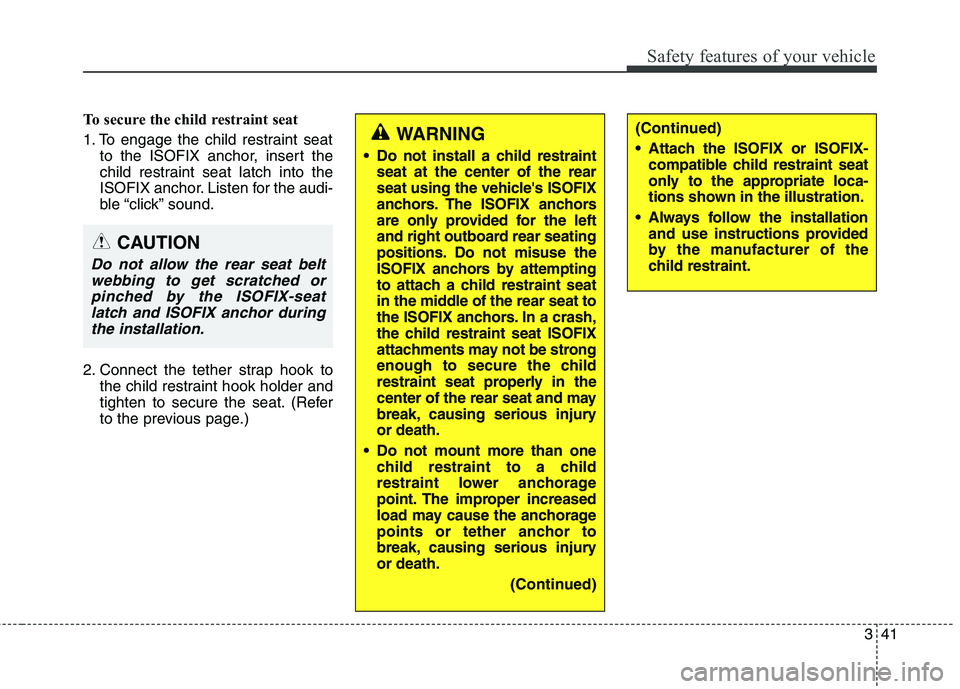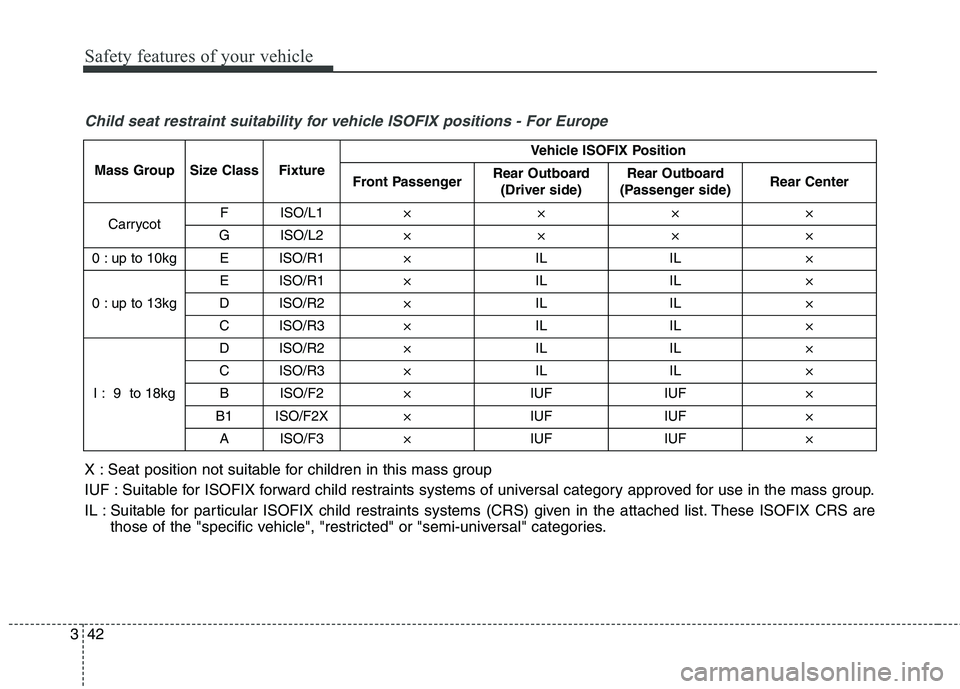2013 KIA QUORIS child seat
[x] Cancel search: child seatPage 55 of 485

Safety features of your vehicle
40
3
There is a child restraint symbol
located on the lower portion of each
side of the rear seatbacks. Thesesymbols indicate the position of the
lower anchors for child restraints soequipped. On each side of the rear seat,
between the cushion and backrest,are located a pair of ISOFIX anchor-age points together with a top tethermounting on the shelf behind the
rear seats. During the installation,the seat has to be engaged at the
anchorage-points in a way you can
hear it clicking (check by pulling!)
and has to be fixed with the Top
Tether-anchor on the belonging point
on the shelf behind rear seats. The installing and the use of a child-seat has to be done according to the
installing-manual, which is added tothe ISOFIX-seat.
WARNING
Install the child restraint seat
fully rearward against the seat-
back with the seatback in a ver-
tical position, not reclined.
WARNING
When using the vehicle's "ISOFIX" system to install a
child restraint system in the
rear seat, all unused vehicle
rear seat belt metal latch
plates or tabs must be latched
securely in their seat belt
buckles and the seat belt web-
bing must be retracted behind
the child restraint to prevent
the child from reaching andtaking hold of unretracted
seat belts. Unlatched metal
latch plates or tabs may allow
the child to reach the unre-
tracted seat belts which mayresult in strangulation and a
serious injury or death to the
child in the child restraint.
Do not place anything around the lower anchors. Also makesure that the seat belt is not
caught in the lower anchors.
OKH032051
ISOFIX Anchor
Position Indicator
ISOFIX Anchor
Page 56 of 485

341
Safety features of your vehicle
To secure the child restraint seat
1. To engage the child restraint seatto the ISOFIX anchor, insert the
child restraint seat latch into the
ISOFIX anchor. Listen for the audi-
ble “click” sound.
2. Connect the tether strap hook to the child restraint hook holder and
tighten to secure the seat. (Refer
to the previous page.)
WARNING
Do not install a child restraint seat at the center of the rear
seat using the vehicle's ISOFIX
anchors. The ISOFIX anchors
are only provided for the left
and right outboard rear seating
positions. Do not misuse the
ISOFIX anchors by attempting
to attach a child restraint seat
in the middle of the rear seat to
the ISOFIX anchors. In a crash,
the child restraint seat ISOFIX
attachments may not be strong
enough to secure the child
restraint seat properly in the
center of the rear seat and may
break, causing serious injuryor death.
Do not mount more than one child restraint to a child
restraint lower anchorage
point. The improper increased
load may cause the anchorage
points or tether anchor to
break, causing serious injuryor death.
(Continued)(Continued)
Attach the ISOFIX or ISOFIX-compatible child restraint seat
only to the appropriate loca-
tions shown in the illustration.
Always follow the installation and use instructions provided
by the manufacturer of the
child restraint.
CAUTION
Do not allow the rear seat belt
webbing to get scratched orpinched by the ISOFIX-seat latch and ISOFIX anchor duringthe installation.
Page 57 of 485

Safety features of your vehicle
42
3
X : Seat position not suitable for children in this mass group
IUF : Suitable for ISOFIX forward child restraints systems of universal category approved for use in the mass group.
IL : Suitable for particular ISOFIX child restraints systems (CRS) given in the attached list. These ISOFIX CRS are
those of the "specific vehicle", "restricted" or "semi-universal" categories.
Child seat restraint suitability for vehicle ISOFIX positions - For Europe
Mass GroupSize ClassFixture
Vehicle ISOFIX Position
Front PassengerRear Outboard
(Driver side)Rear Outboard
(Passenger side)Rear Center
Carrycot FISO/L1××××
GISO/L2××××
0 : up to 10kgEISO/R1×ILIL×
0 : up to 13kg
EISO/R1×ILIL×
DISO/R2×ILIL×
CISO/R3×ILIL×
I : 9 to 18kg
DISO/R2×ILIL×
CISO/R3×ILIL×
BISO/F2×IUFIUF×
B1ISO/F2X×IUFIUF×
AISO/F3×IUFIUF×
Page 60 of 485

345
Safety features of your vehicle
Noise and smoke
When the air bags inflate, they make
a loud noise and they leave smoke
and powder in the air inside of the
vehicle. This is normal and is a result
of the ignition of the air bag inflator.
After the air bag inflates, you may
feel substantial discomfort in breath-
ing due to the contact of your chestwith both the seat belt and the air
bag, as well as from breathing the
smoke and powder.Open your
doors and/or windows as soon as
possible after impact in order to
reduce discomfort and prevent
prolonged exposure to the smoke
and powder.
Though the smoke and powder are
non-toxic, they may cause irritation
to the skin (eyes, nose and throat,
etc). If this is the case, wash and
rinse with cold water immediatelyand consult a doctor if the symptom
persists.
Do not install a child restraint on
the front passenger’s seat.
Never place a rear-facing child
restraint in the front passenger’s
seat. If the air bag deploys, it would
impact the rear-facing child restraint,
causing serious or fatal injury.
In addition, do not place front-facing
child restraints in the front passen-
ger’s seat either. If the front passen-
ger air bag inflates, it could cause
serious or fatal injuries to the child.
1JBH3051
WARNING
When the air bags deploy, the
air bag related parts in thesteering wheel and/or instru-ment panel and/or in both sides
of the roof rails above the front
and rear doors are very hot. To
prevent injury, do not touch the
air bag storage area’s internal
components immediately after
an air bag has inflated.
Page 61 of 485

Safety features of your vehicle
46
3
Air bag warning light
The purpose of the air bag warning
light in your instrument panel is to
alert you of a potential problem with
your air bag - Supplemental
Restraint System (SRS).
When the ignition switch is turned
ON, the warning light should illumi-
nate for approximately 6 seconds,
then go off.
Have the system checked if:
The light does not turn on briefly
when you turn the engine
start/stop button to the ON posi-tion. The light stays on after illuminating
for approximately 6 seconds.
The light comes on while the vehi- cle is in motion.
The light blinks when the engine start/stop button is in ON position.WARNING
Extreme Hazard! Do not use a rearward facing child restraint
on a seat protected by an air
bag in front of it!
Never put a child restraint in the front passenger’s seat. If
the front passenger air bag
inflates, it can cause serious
or fatal injuries.
When children are seated in the rear outboard seats of a
vehicle equipped with side
and/or curtain air bags, be
sure to install the child
restraint system as far away
from the door side as possible,
and securely lock the childrestraint system in position.
Inflation of side and/or curtain
air bags could cause serious
injury or death to an infant or
child.
W7-147
Page 66 of 485

351
Safety features of your vehicle
The SRS consists of air bags
installed under the pad covers in the
center of the steering wheel , in the
knee bolster below the steeringwheel column and the passenger's
side front panel above the glove box.
The purpose of the SRS is to provide
the vehicle's driver and/or the frontpassenger with additional protection
than that offered by the seat belt sys-tem alone in case of a frontal impact
of sufficient severity. The SRS uses
sensors to gather information about
the driver's seat position, the driver'sand front passenger's seat belt usage
and impact severity.The seat belt buckle sensors (if
equipped) determine if the driver and
front passenger's seat belts are fas-
tened. These sensors provide the
ability to control the SRS deploymentbased on whether or not the seat
belts are fastened, and how severe
the impact is.
WARNING
Always use seat belts and child
restraints – every trip, every
time, everyone! Air bags inflate
with considerable force and in
the blink of an eye. Seat belts
help keep occupants in proper
position to obtain maximum
benefit from the air bag. Even
with air bags, improperly andunbelted occupants can be
severely injured when the air
bag inflates. Always follow the
precautions about seat belts, air
bags and occupant safety con-
tained in this manual.
To reduce the chance of serious or fatal injuries and receive the
maximum safety benefit from
your restraint system:
Never place a child in any child or booster seat in the
front seat.
ABC – Always Buckle Children in the back seat. It is the safest
place for children of any age
to ride.
(Continued)
OKH032055
Passenger’s front air bag
Page 68 of 485

353
Safety features of your vehicle
(Continued)Do not sit or lean unnecessar-
ily close to the air bag while
the vehicle is in motion.
Sitting improperly or out of position can result in serious
or fatal injury in a crash. Alloccupants should sit upright
with the seat back in an
upright position, centered onthe seat cushion with their
seat belt on, legs comfortably
extended and their feet on the
floor until the vehicle is
parked and the ignition key is
removed.
(Continued)(Continued)
The SRS air bag system mustdeploy very rapidly to provide
protection in a crash. If anoccupant is out of positionbecause of not wearing a seat
belt, the air bag may forcefullycontact the occupant causingserious or fatal injuries.(Continued)
A child restraint system mustnever be placed in the front
seat. The infant or child could
be severely injured or killed
by an air bag deployment incase of an accident.
Children age 12 and under must always be properlyrestrained in the rear seat.
Never allow children to ride in
the front passenger seat. If a
child over 12 must be seated
in the front seat, he or she
must be properly belted and
the seat should be moved as
far back as possible.
For maximum safety protec- tion in all types of crashes, all
occupants including the driv-
er should always wear theirseat belts whether or not an
air bag is also provided attheir seating position to mini-
mize the risk of severe injury
or death in the event of acrash.
(Continued)
Page 71 of 485

Safety features of your vehicle
56
3
WARNING
In order for side and curtain air bags to provide the best
protection, front seat occu-
pants and outboard rear occu-pants should sit in an uprightposition with the seat belts
properly fastened.
Importantly, children should
sit in a proper child restraintsystem in the rear seat.
When children are seated in the rear outboard seats, they
must be seated in the proper
child restraint system. Make
sure to position the child
restraint system as far away
from the door side as possi-
ble, and secure the child
restraint system in a lockedposition.
(Continued)(Continued)
Do not allow the passengersto lean their heads or bodies
onto doors, put their arms on
the doors, stretch their arms
out of the window, or place
objects between the doors
and passengers when theyare seated on seats equipped
with side and/or curtain air
bags.
(Continued)(Continued)
Never try to open or repair anycomponents of the side curtain
air bag system. We recommend
that the system be serviced by
an authorized Kia dealer.
Failure to follow the above men-tioned instructions can result in
injury or death to the vehicleoccupants in an accident.
1KMN3664